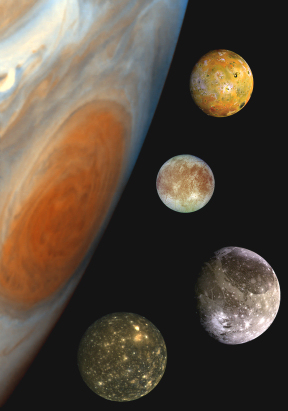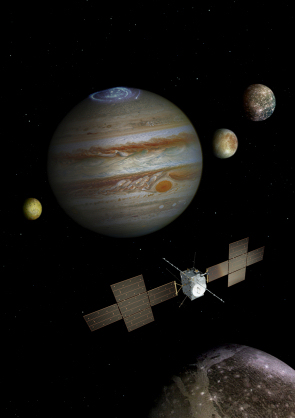JUICE ground control gets green light to start development of Jupiter operations
16 January 2018
ESA's Jupiter Icy Moons Explorer – JUICE – passed an important milestone, the ground segment requirements review, with flying colours, demonstrating that the teams are on track in the preparation of the spacecraft operations needed to achieve the mission's ambitious science goals.Planned to launch in 2022, JUICE will embark on a 7.5-year long journey through the Solar System before arriving at Jupiter in 2029. There, it will spend three and a half years examining the giant planet and its environment, in particular investigating the Galilean moons Ganymede, Europa and Callisto, which are thought to conceal oceans of liquid water beneath their icy crusts.
To explore the atmosphere, magnetosphere and tenuous rings of Jupiter, as well as to characterise its three ocean-bearing moons, JUICE will sport ten state-of-the-art instruments. These include cameras, spectrometers, a sub-millimetre sounder, an ice-penetrating radar, an altimeter, a radio-science experiment, and sensors to monitor the magnetic fields and particle environment, as well as a radio interferometry experiment.
After confirmation of the spacecraft design and the first tests on individual pieces of the equipment, the mission has now gone through another important step, successfully showing that the ground teams that will operate JUICE and its suite of science instruments meet all the necessary requirements.
While space missions operate beyond the realm of our planet, the bulk of the work is actually conducted by engineers and scientists on Earth – the ground segment – who plan the activities, monitor, command and communicate with spacecraft so that they point in the desired directions to gather the data needed by the scientific community.
ESA's contribution to the ground segment of JUICE consists of the Mission Operations Centre (MOC), which is based at the European Space Operations Centre (ESOC) in Darmstadt, Germany, and also includes the ground stations and communications network; and the Science Operations Centre (SOC), based at the European Space Astronomy Centre (ESAC) near Madrid, Spain.
The ground segment requirements review, with the aim of assessing the overall implementation and progress of both the MOC and SOC, was completed on 13 December 2017.
"With this successful review, we confirmed that the JUICE ground segment is on track to deliver the great science expected by the community," says Olivier Witasse, ESA JUICE project scientist.
 |
| Jupiter's largest moons. Credit: NASA/JPL/DLR |
As is the case for other missions, the MOC is responsible for commanding the spacecraft, monitoring its health and returning the data. Besides that, it is also in charge of a series of mission-specific functions, such as calculating the complex trajectory that will take JUICE to Jupiter, which includes five planetary gravity assist manoeuvres at Venus, Earth and Mars, as well as preparing for the spacecraft operations in the Jovian system, involving 26 flybys of Ganymede, Europa and Callisto, and eventually orbit injection around Ganymede.
The SOC is instead responsible for planning the science observations to be conducted with the ten instruments on-board of JUICE to maximise the scientific return of the mission. This entails the scheduling of spacecraft pointing to the various observation targets – Jupiter, the moons, the plasma environment, the magnetic field – and of the different operating modes to be employed by each instrument.
The review board verified that the mission requirements for the ground segment, including operations of both the spacecraft and payload, are fully met. Special attention was dedicated to the specific needs of the instruments that are part of JUICE's payload relevant to all phases of mission operations, from calibration measurements during the long cruise phase to the challenging operations in the Jupiter system.
As part of the review, the mission concept and the ground segment design were also addressed, as well as all details pertaining the organisation of work, from procurement to scheduling and overall management, making sure that potential critical areas have been identified and appropriate risk-mitigation measures have been defined.
After the successful review, the JUICE MOC and SOC will now proceed to the next phase, designing their respective implementation; a further review of the ground segment design is planned for the end of 2018.
"This year will be very crucial for the JUICE programme, with three key milestone to come: a Sun illumination test in April, which will simulate the conditions of the Venus fly-by on the full-scale thermal model of the spacecraft; the start of the engineering model test campaign in mid-2018; and the kick-off of the critical design review at the end of the year," says Giuseppe Sarri, ESA JUICE project manager.
"So far all preparation activities are running as expected, in line with the planned launch date on 20 May 2022."
For further information, please contact:
Giuseppe Sarri
ESA JUICE project manager
Email: Giuseppe.Sarri![]() esa.int
esa.int
Olivier Witasse
ESA JUICE project scientist
Email: Olivier.Witasse![]() esa.int
esa.int



